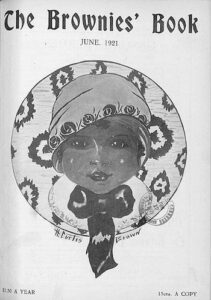
The Brownies' Book, 1921
*The Brownies' Book publication is celebrated on this date in 1919. This was the first magazine published for African American children and youth in the United States.
Three people created the magazine. Its editor was W. E. B. Du Bois, one of the founders of the NAACP, and its business manager was Augustus Granville Dill. The magazine's literary editor was Jessie Redmon Fauset.
Each year, The Crisis published an issue referred to as the "Children's Number," which included stories, photographs, games, poetry, and educational achievements of black children. These issues also contained more severe information. Du Bois covered lynching and violent attacks on Blacks because he was concerned about the effects that reports of these incidents would have on black children. In the October 1919 "Children's Number" issue of The Crisis, Du Bois stated that it was "designed for all children, but especially for ours," with a target audience of children and youth between six and 16 years old.
One of the magazine's goals was to dispel the "grotesque stereotypes" of the "Dark Continent," a disparaging term for Africa and its people. Middle-class African American children "consumed this propaganda along with the white children who were its implied audience" in children's literary works such as those of the magazine St. Nicholas.
The 1919 article "The True Brownies" included commentary by Du Bois discussing children, stating that "to seek to raise them in ignorance of their racial identity and the peculiar situation is inadvisable—impossible," in which the use of the phrase "peculiar situation" is an allusion to the euphemism "peculiar institution," meaning slavery. Du Bois believed children should be taught their racial identity and social situation.
The magazine's name is derived from the folkloric brownies. These creatures were said to complete household chores at night in exchange for food, alluding to African Americans being used as servants. Still, the term is used as signification in the "oppressive literary-historical context." Specifically, the creators wanted to "make colored children realize that being 'colored' is a normal beautiful thing."
The seven goals stated in "The True Brownies" were:
*To make colored children realize that being "colored" is a normal, beautiful thing.
· To make them familiar with the history and achievements of the Negro race.
· To make them know that other colored children have grown into beautiful, useful, and famous persons.
· To teach them a delicate code of honor and action in their relations with white children.
· To turn their little hurts and resentments into emulation, ambition, and love of their homes and companions.
· To point out the best amusements and joys and worthwhile things of life.
· To inspire them to prepare for definite occupations and duties with a broad spirit of sacrifice.
— W. E. B. Du Bois, "The True Brownies", The Crisis, October 1919.
Another goal was to expand black children's literature canon, in which fiction and fantasy were rare, and to encourage youth participation in the NAACP. It also intended to develop The Talented Tenth, capable African Americans in the top decile who could become leaders in the black community. Issues were published monthly until December 1921. It is cited as an "important moment in literary history" for establishing Black children's literature in the United States.
To be a Writer
To Become an Editor
To Become a Desktop Publisher